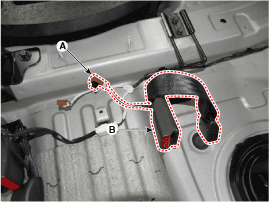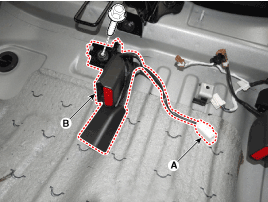Hyundai Kona: Rear Seat Belt / Rear Seat Belt Buckle Repair procedures
Hyundai Kona (OS) 2018-2025 Service Manual / Body (Interior and Exterior) / Rear Seat Belt / Rear Seat Belt Buckle Repair procedures
| Replacement |
| 1. |
Remove the rear seat cushion assembly.
(Refer to Rear Seat - "Rear Seat Cushion Assembly")
|
| 2. |
Disconnect the connector (A) and then remove the rear seat belt buckle
(B).
[LH]
[RH]
|
| 3. |
To install, reverse removal procedure.
|
 Rear Seat Belt Buckle Components and components location
Rear Seat Belt Buckle Components and components location
Component Location
1. Rear seat belt buckle [RH]
2. Rear seat belt buckle [LH]
3. Rear center seat belt buckle
...
Other information:
Hyundai Kona (OS) 2018-2025 Service Manual: Knock Sensor (KS) Repair procedures
Removal
1.
Turn the ignition switch OFF and disconnect the battery negative (-)
cable.
2.
Remove the intake manifold
(Refer to Engine Mechanical System - "Intake Manifold")
3.
Remove th ...
Hyundai Kona (OS) 2018-2025 Service Manual: Piston and Connecting Rod Components and components location
Components
1. Piston ring
2. Piston
3. Connecting rod
4. Connecting rod upper bearing
5. Connecting rod lower bearing
6. Connecting rod bearing cap
7. Piston pin
8. Snap ring
...
© 2018-2025 www.hkona.com




